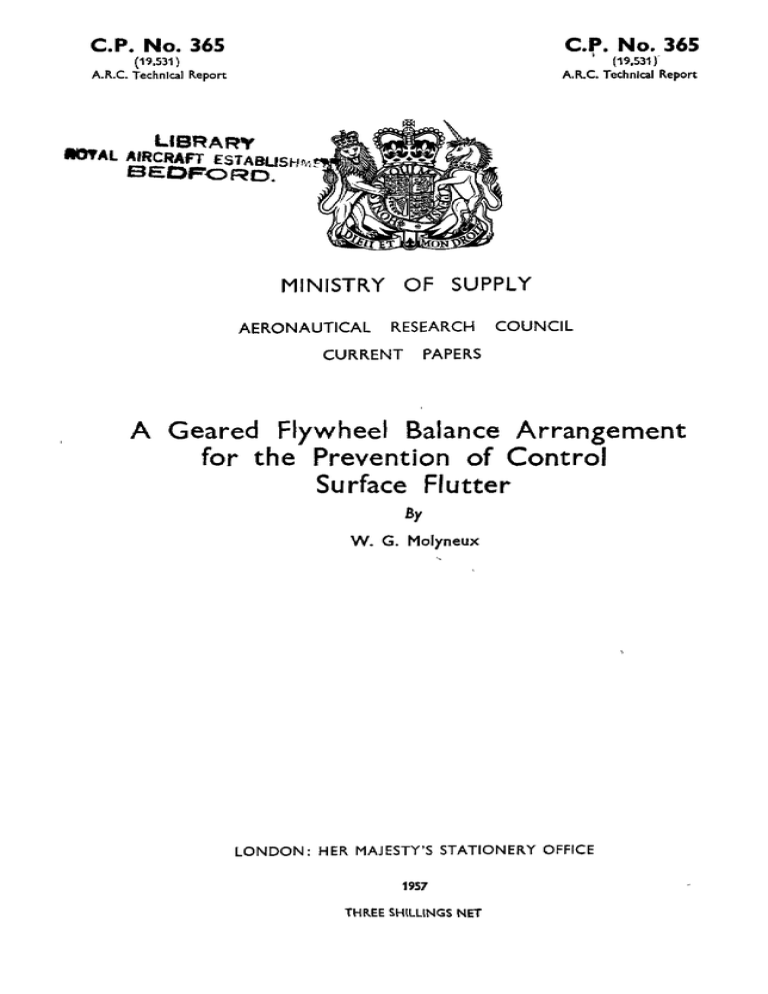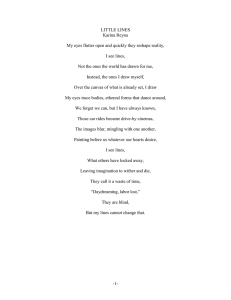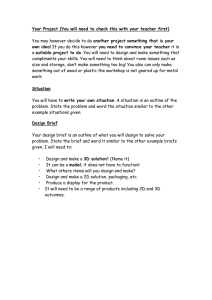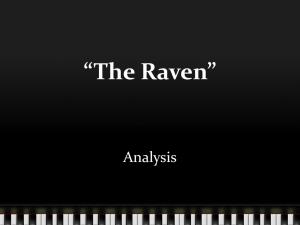A Geared Flywheel Balance Arrangement for the Prevention of
advertisement

C.P. No. 365 C.P. No. 365 (19.531) (19.531) A.R.C. TechnIcal Report A.R.C. TechnIcal Report mAL tlf3RARV AIRCRAfT ESTABUSHti 6E&PORD. MINISTRY AERONAUTICAL OF SUPPLY RESEARCH CURRENT COUNCIL PAPERS A Geared Flywheel Balance Arrangement for the Prevention of Control Surface Flutter BY W. G. Molyneux )I LONDON: HER MAJESTY’S STATIONERY 1957 THREE SHILLINGS NET OFFICE C.P. mo. 365 V.D.C. No. 621-562 : 533.691.155 : 533.6.013.&22 Report No. Structures 224 June, 1957 ROYAT.,AIlKE*m ESTABLS- A geared fiywheel balance arrangement for the prevention of control surface flutter by PI. G. ?ilolyne.u~ Some geared massbalence q-stem:, are deecnbed that are ef'fectxve m elkurxting ~nertid couplings between modes of the main surface end the cant rol surfam. These arrangements are shoxn to have an advantage over the conventional arreqement for preventing flutter involving main surface torsion and control rotation, pertmcular~y where there is a near f'reqaenoy coinosdance between the modes. Introduction 3 Tne arrangements 2.1 Reammrd 2.2 Statically Flutter consxdered facing 3 geared balanced balsnce control am mth 3 geared flywheels 5 in-mstigation 3.1 Comparison 3.2 Duect 3.3 Flywheel 6 of direct balance bslance balance wrth in association lath geared balance flywheelbalame alcne am system 6 7 7 Dxcusslon 8 Conclusions 8 TAKE Table I LIST OF ILUJSTRATIONS FL&& Rezimmrd faomg Statically geared balanced balance control with am system 1 geared 2 flywheel 3 Wing details Comparison of duect and geared balance am systems Effect of geared flywheel - statloallji balanced Effect of geared flweel -unbalanced control -2- control & 5 6 1 Introduction The conventional method of provldmg massbalance for control surfaces is by the direct attachment of masses to the control surface fome.rd of the hinge. It 1s generally possible, by thus means, to reduce to zero the inertia couphng for a selected type of bxnary motion (e.g. onng flexurz-slleron rotation, wing torsion-aleron rotation), but zero coupling cannot be achieved when flexuraland torsional modes of the maxn surface have to be consx3ered suultanecusly. To avoid this dlffxulty Frazer' has suggested an nlternatlve balance arrangement consisting of a rearward facing massbalsnco azm, pivoted about the hinge axis of the control surface snd geared to the surface so as to 35th thxs system rotate in the opposite sense to the surface rotation. dynamxc balance of the surface can be obtained for any mode of -mng distortion provided the control surface can be treated aa rigid. Unfortunately, with the present trend towards very thin wing sections, the assumption of control surface rigxdity cannot be justified. To allow for control surface TlexlbClity a firther form of geared balance is considered, consisting of a comblnatwn of a statically balanced control zurface (balanced. in the conventional manner) and a system of flywheels geared to the control to rotate m the opposite sense to the control surface mtat Ion. Xth thu arrsxgement the inertial couplings between wing and control surface motions can be reduced to sero for any mode of distortion of the wzng or control surface. However the elzunat~on of inertial couplings does not necessarxly imply that the system Nil1 benefit over the conventzonal system as a flutter preventive. Accordingly a flutter investlgatzon has been made to compare the relative effectxveness m preventflutter of the two geared systems and the conventional system. This shows that both geared balance sxln snd flywheel balance arrangements have a marked sdvzntage over conventional direct balance in preventxng flutter of the man surface rotation - control surface rotation type, partuxlarly where there I.S a near frequemy has proved troublesome coincidence between the modes. Wiis type of flutter on some recent aircraft deslf;ns. 2 The arrngements 2.1 Rearward condered facxrw geared balzaoe arm The system 1s as shown in Fig.1. Let sa anx3 zb denote arbztrary vertlca'l dlsplscements of the wing at the hinge attachments distame a and b respectively frcm the vnng root, let VC denote the angular duplacement of the wing at the se&Jon c for control operation and ~0 the rotation of the axleron relative to the wing at this sectzon. Then the vertical l..xnear displacement of a point P(x,y) on the control IS b) c eh(a - y) ‘a If 6m denotes generalmot3.on is 2T = (’ - n _ the mass at >7 j axleron i,(Y 6n b + duo + P,) P then the total - b) + ;',,(" - Y) a - 0 . kinetic energy in a 2 . (1) The mng iuleror. ipertml cmplmgs III t&s expression involvmg products of p, mth za , zb and Kc , 1.e. Coeffloient of 3 f?, La are those terns (C&my - bC&nx) (24 (2b) and mertial couplug is elminated when all these coefflclents are zero. If massbalance is to be achieved by the direct attachment of a dlstrlbuted or concentrated mass forward of the aileron hinge then it 1s apparent that all the expressions (2) cannot be zero. ExpressIon 2(c) for example ml1 always havz a rea!, positive value, indicating that due& balance cannot provide zero inertia coupling a a pitch mode involviq rotatron of the rn.un mrfnce about the control surface hinge. Iiowever, suppose that massbalance 1s to bz achieved by a concentrated c , pivoted about the Mb on a rearward facing arru xb at section hinge 8x1.~ of the control surface, and geared to the surface so as to rotate Let the gear ratlo massbalance m the opposite sense to the surface rotation. arm rotation: control surface rotation be g . For this system the klnetlc energy 3.n a general motion ~5 WdSS r (3) and the mertlal coupling CoefrZclent 611 expressrons of (4) will coeffzcients P’, la are &- (C6mq - bC&x - $b,c be zero .ahen the following conditions + bpbxb) are satisfied. lb) X:atlon (5) determined the section for massbalance attachment and control operation, (6) defines the length of the (weightless) mussbalance arm snd (7) detemmes the balance mass. c It 1s apparent that by usmng this massbelanoe arrangement the inertial cmpl.angs cm be reduced to zero. However, the system has the dlsadvantsges that the control surfaoe must be slotted to allow movement of the balance arm, leading to aerodynamic Interference and structural dafficulties, snd flexlbllity of the control surface can reduce the massbalance effectiveness. q , thx reducRzthennore, it is not prsctlcable to use a tigh gear ratio ulg the mass required for massbaisnce, becase if the gear ratlo dlf'fers greatly from unity the massbalame effectiveness will vary considerably It may be noted that the over the range of control surface travel. effective moment of inertia of the control surface TS given by I where 2.2 Ia = is the moment of inertza Statlcallg balanced control (1iq)Ia of the unbalanced control. mt-h Reared flywheels" Then there 1s slg~ficant ilexlbliity of the control surface wrthln the frequency range for flutter it 1s potentially dangerous to attempt to massbalsnce vslth a single concentrated mass, such as is required with the above srrargemen~ . In an utlfavourable mode of drstortlon it is possible for an arrangement of this sort to act in the a&l-balance sense. For the flexible control surface an alternative arrangement 1s therefbre required. within control control Now consider the system shown m Fzg.2 m which there LS a shaft the vsme; that carries a series of discrete flywheels, geared to the surface vnth gear ratlo q to rotate in the opposLte sense to the surface m-t&.0x.. The totalklnetic energy 2r = .I m leron in a general motion Srn [k + x(c; c &I2 is + 2 I(o; - q$ where I is the local fl;Yvrheelmoment of lnertla all functxms of the s-ps%zse cootiinate. and To satisfy the cond~txm of zero u-uzt~al coupling d~storhon of the control surface the lnertlal coupling at every local sectx.on. At a local sectmn we have:Coefficient of 6; z, a, snd 6 are for any mode of terms nn& be zero 2cSmx These expressions ~a11 be zero provided every local section 1s massbalazed so that its c.g. 1s on the hinge line, and provzded the local value of q1 for the fly&eels 1s equal to the local moment of inertia of the control surface. In this condltlon the control inrlll be statically balanced and its total effective moment of Inertia I will be I = where Ib is the moment of lnertla c.3rfzse. *Patent &pLcatlon 34009/56. (1 + q)Ib of the statically -s- (10) balanced control With this arrangement the whole balance system can be housed within the wing contour thus avoiding aer0dynsnri.c interference. Furthermore, high gear ratios can be used thus reducrng flyThee mass, though it should be noted that the effective control inertiav&l ancrease with gear ratio. In practice it is rarely convenient to utilise an ideally distributed balance system, the usual practice being to concentrate the balance at three or four sections along the span of the control, For the present system this would requre a directly mounted mass to balame a particular portion of the control surface and a geared flywheel to balance the moment of inertia of this seme portion. 3 Flutter investigation Reducing inertial couplings to zero does not necessarily avoid flutter entirely, sance aerodynamic and elastic couplings will generally still be present. In what follows a l~miteed theoretical investigation is therefore made to oompare the efrectivenlss of the conventional balance system with that of the geared balance arm snd geared flywheel balance systems. A ragid wing section is considered with freedoms in vertical translation, pitch about the quarter chord snd aileron rotation. The main details of the "mng are given inFig. an3 Table I. Two dimensional incompressible flow derivatives are used for a fixed frequency parameter of 'I .4, and flutter properties are investigated for different massbalance conditions over a rsnge of control circuit stiffness that ensures a coincidence between the frequencies of the wing and control surface modes. 3.1 Comparison Referring of the arm for of direct balance vvlth geared balame arm system to equation (6) and using the data from Table the geared balance system is I, the length 2 Xb= y&-. = 0.65 f% . For simplicity it is asnuned that this ssme length of arm is used for the direot balame system, so that static balame of the control 1s obtained for both systems vvlth a mass of about 0.031 slugs at the end of the arm. Flutter curves for different values of the balance mass and for of control circut stiffness are shown in Fig.4. The gear ratio for geared balance IS assumed to be unity throughout. a range the FOX7a balsnce mass of zero it can be seen that two distinct types of flutter occur. When the circuit stiffness is low the flutter is of type (A) which involves modes of vertical translation and control rotation, pitch of the main surface having an insignificant effect. As the circuit stiffness is which involves wing increased there is an abrupt chsnge to t e (B) flutter pitch and control rotation. The type (A 3" flutter region is the sane for both geared and dxect balance systems, and disappears entirely for a balance mass of 0.025 slugs/f%, but the ty*x (B) flutter regions differ considerably for the two systems. Whereas for the geared balance the low flutter speeds associated with type (B) flutter are avoided with a balance mass of 0.031 slugs/f% (i.e. static balance), a comparable condition is not &sieved with the direct balance system until the balance mass is increased to 0.05 slugs/f%. With direct balance a balance mass some 5C$ in excess of that reqrured for static balance of the control is therefore necessary to avoid the low flutter These low speed region for the pitch-aileron rotation type of flutter. flutter speeds result from a near comoidenoe of the vvlng pitch and control -6- rotation frequenclec, m assoc~at~n with unfavourable inertial couplings between wing and control motions. 7hth the geared balance system the unfavourable inertial couplings are elismnated when the static balance condztlon obtains. krect 3.2 balance in assoclatlon with flywheel bslsnce The case considered is that of statically balanced control with a mass of 0.031 slugs/f% on a balance atm 0.65 ft long (as m se&Ion 3.j) to which a flywheel is geared. The effects of variation in flywheel inertia are uvestigateed for two values of the gear ratio control are shorjn In :;f; . . flwheel The remlts mtation mtat=on > - The flutter obtained IS of the torsion-s~.leron type throughout, static b&we having eliminated the translation-aleron type flutter. It can be seen that ior correspondxng vCues of q1 the minimum flutter speed is about the some for both values of q , but the flutter region extends over a greater rengc of circuit stiffness when q = 3 than when q = 1. As q1 is increased tQe minimzu~ flutter speed increases rapidly, and when q1 = 0.026 slugs ft /i-t (i.e. inertial coupling sero) the speed IS everywhere greater than 900 ft/sec (as compared with 180 ft/sec when q1 = 0). A r?lrther increase in q1 leads to a illrtherincrease in the minimum flutter speed for q = I, and a skght decrease for q = 3. The mirumum flutter speeds when inertial couplang IS zero (q1 = 0.026) are almost identical. with that for the corresponding condition with the geared balance arm (x = 0.031), indicating that both systems are equally effective in raising the minxmum speed. Flywheel 3.3 balame alone It is of interest to investigate the effect of using fl@eel balance alone on the flutter of an unmsssb,sl-anced control surface. Obviously, since the flywheel presents an opposing moment of inertia sganst control surface rotation it cannot elunlnate the mass-moment inertia coupling that results from translation of the main surface. In consequence fly&eel balance alone would not be expected to elrocmate flutter of the flexureaileron type, though it should be effective for torsion-aleron type flutter. This is borne out by the results show mFig.6, in which the effect on flutter of fl&xel balame alone has been investigated for gear ratios q of 0.5 and 1.0. It is apparent that the area of torsion-aileron flutter inertia is increased, but the area @I is markedly reduced as the flywiiecl of flexure-aleron fiutter (A) is increased because of the resultant increase in the effective moment of inertia of the control surface. The efr'ective control surface moment of inertia is given by 1 where Ia If is the moment of inertia is the Iflywheel The localvalue gxven by - of CIa"q2If) of the unbalanced control surface inertia from which it is apparent that excessively large value of I. if = If a low gear ratio required to eliminate -74 is required to avoid torsion-aleron an coupling 9 if where ia = ia c ma XaC is the local moment of inertia of the unbalanced control ma is the local mass of the unbalanced control ;; a 1s the distsnce c is the distance hinge, of the c.g. of the local between the torsional surface surface section nodal line aft of the hinge and the aileron which indicates that the vslue of If required reduces as the nodal line approaches the aileron hinge and is a minimum when these two axes coincide. With a direct balance arrangement the mass requared to eliminate this form of coupling inareases as the nodal lrne approaches the hinge, tending to infirdty when it ooincides with the point nf installation of the balance mass. Flywheel balance alone may therefore have sn advmtsge over direat balance in any ciroiastame where the nodal line for torsion-aileron flutter is close to the hinge, provided the flexure-aileron flutter bramh can be avoided (e.g. by providing an adequate circuit stiffness). 4 Discussion It may be noted that the penalty for the elimination of inertial couplings is a marked increase in the effective moment of inertia of the control surface as compared with that for conventional massbalance. In consequence a greater initial force is required to achieve the ssme rate of control application, snd s?rthemure, it becomes increasingly difficult to achieve a high natural freqnemy for the control on its circuit. Though the letter feature may no longer be Important so far as coupled flntter is concerned it msy well be important in the low supersonio speed regime where single degree of freedom flutter can occur due to negative aerodynamic damping for the control surface. If the frequency of the control on its circuit can be made high enough this region of negative damping can be avoided2. However, even wnth a conventional massbalance system the required frequency often cannot be achieved, and the alternative in such cases is to elaminate the flutter by the intmduction of damping. With a flywheel massbalance system it seems likely that damping units could be housed within the flywheels themselves. The "flywheels" need not of course be in the form of circular discs but might equally we.11 consist of linkage arms pivoted at their centres; they could be incorporated as part of the circuit through which the control is operatea. The system is open to the usual objections regarding any geared massbalance system, namely, there must be no undue flexibility in the linkage snd backlash mst be kept to a mininmm. Furthermore, the danger of ~amaing the mechanism due to icing or due to differential expansion arising from kinetic heating must also be borne in mind, but the system is unlikely to be u?orse off on any of these counts than ssy a power operated control using sorew ja&s or hydraulic aotuators. 5 Conclusions The conventional control surface massbalame arrangement, whereby a balance mass is attached direct to the control on a forward facing am, does not enable the aimulteneous elimination of mertGl. couplings for vertical displacement and pitch modes of the main surface to be achieved. Massbalarme for main surface pitch is impractic&le for amode whose nodal line Yues close to the control surface bange. -8 - A theoretical lnvestzgatlon of two alternative arrangements of geared massbalame show that they are more effective than the conventional arrwemerit in eliminating uxztial couplings, snd they benefit greatly over the conventioilal system m preventing flutter of the torsion-slleron type where there is a near coincidence of frequerxles. IIowever, the arrangement conslsting of a rearward facing bdarvle s.xm geared to rotate about the control su-faco hinge in the opposite sense to the control sxface rotation presents an udallat~on problem since it would normally proJect into the &-stream. Furthermore, the massbalance effectiveness will be influenced by fletibxlity of the control surface or of the balance arm. The alternative arr-angement of YlyWheels geared to a statxcally bslsnced The fly&eels can be housed vathan the control overcomes these Clxffuxltles. The wing ltself an3 sre effective even for a ilexlble control suface. regardmg geld arrangement Is, of course, oren to the usual objections massbalance; namely, there must be no u&x flexibility xn the linksge and system IS backlash must be kept to a muumum. However, the fl~tieelbalance worth consderation in any circumstarvse where the flutter is of a pztchcontrol mtatlon type %%th a near fre;wency colncdence bet,veen the modes, and where the nore usual method of flutter prevantlon by increasug the control circuxt stiffness 1s Impractio&le. No. Title, Author I Fraser, 2 &o&bent, R. A. Z. G. Note on a 'scissors-type' for control surfaces. R & $1 2369 July, 1941. etc. of ciynanic balance Aero-elastic problems in connection with high speed flight. Journal of the Royal Aeronautical Society, July, '1956. - Y- TABLE I Wing details Wing mass = 1.0 slugs/f% span (including Wing chord = 5.0 ft (including aleron) Wmg c.g. = 1.25 ft af't of leading Wing radius of gyratmn Wing vertical edge = 1.25 f% about quarter trenslet3.on = 200 rads/sec Plleron c.g. = 0.096 ft aft of h.xnge line Aileron mars = 0.21 slugs/f% Aileron radius of gyration - Prmted = 0.25 ft about huge line = 0.2 - 10 K~.2078.C.P.385.K3 m Weot chord frequency = 100 rds/sec Wmg patch frequency Axleron chord wing chord aileron) Eritcain. - 5 ii DATUM Z , WING. /CONTROL FIG. 2. STATICALLY BALANCED CONTROL WITH GEARED SURFRCE. FLYWHEEL. WING PLANFORM. DATUM. -I- . t DEGREES FIG.3. THE OF FREEDOM. SYSTEM CONSIDERED. . . , . 1500 IO00 VC 500 0 1000 91 =o E 0 3000 ta+.I = 0*030 1000 E qI= a= 2000 0.068 O-5 VC= FLUTTER SPEED -FT/SEC. E = CIRCUIT STIFFNESS - LB.FT/RAO. I t FLYWHEEL INERTIA - SLUGS FT’/ FT. FLYWHEEL ROTATION e= GEAR RATIO - CONTROL ROTAT\O N . E 71’ FIG. 6. EFFECT OF GEARED 2000 o-03 3000 9 = I’0 FLYWHEEL-UNBALANCED 91 =O-068 CONTROL. 3000 C.P. No. 365 (19.531 J A.R.C. Techneal Report Crown copynghf reserved Pubbshed by HDR MAJR~TY’S STATIONERY OFFICC To be purchased from York House, Kmgsway, London w c 2 ~3 Oxford Street, London w I 13~ Castle Street, Edmburgh z 109 St Mary Street, Cardiff 39 Kmg Street, Manchester z Tower Lane, Bristol I z Edmund Street, BImungbam 3 80 Chichester Street, Belfast or through any bookseller S.O. Code No. 23-9010-65 C.P. No. 365


